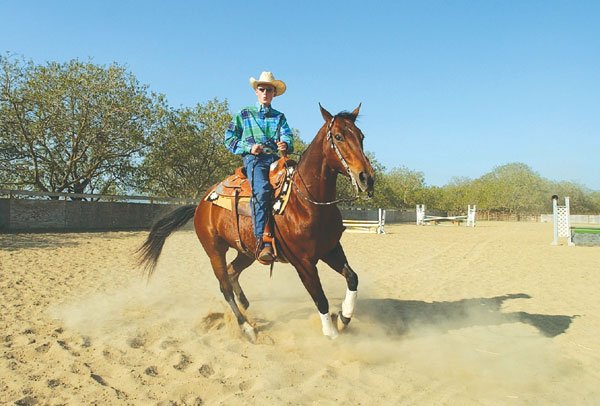Gamble wins nat’l championship in working cow-horse
GILROY – Before John Gamble was even born, his parents had a pony waiting for him. By the time he could sit up, he was in the saddle, learning how to ride and handle it.
Ever since, Gamble, now 14, of Gilroy, has continued on the family tradition, which was passed along to him by his parents, Randy and Celia, who train riders at their stables on the southern edge of Santa Clara County.
“He’s been riding mostly all of his life,” said Randy Gamble, who instructs area riders in the working cow-horse class. “He’s fourth generation.”
The Brownell Academy eighth-grader’s vast experience and hard work paid off recently when he won the National Reined Cow Horse Association Championship in the 18-under class. His reward was a national championship belt buckle that he wears with pride.
“It feels good,” said Gamble of putting on his newest buckle.
“It’s everything,” the proud father added. “It’s what it’s all about.”
Gamble will be the first to admit it takes more than just the rider to win at competitions. The horse plays a major part as well, and Gamble has been riding one of the best. Gamble’s teammate is his horse, called Tux-N-Tails, who is one of 44 horses with a supreme rein cow-horse status, earning $20,000 in competition. The 19-year-old horse has been competing for 16 years, winning several national and world championships.
“They’ve always gotten along,” said Celia Gamble, who purchased Tux-N-Tails from a friend. “John’s got a natural gift and a feel with horses that sets him apart from other riders. He’s very focused when he shows. Therefore, he’s successful.”
Riders are graded on two separate parts of the Cow Horse, or Bridle Horse. The first is called dry work. This is when the rider does one of eight patterns in the rule book. There is a series of maneuvers on the horse, including circles, figure 8s, sliding stops, and spins, that the rider must do in a predetermined order. A rider is scored from 80, which is perfect, to as low as 60. The average for a rider is 70.
The second part is called cow work. This is when a single cow is turned loose in the arena. The rider must first box the cow and hold it on one end. Once he shows that he has the cow in control, the rider must direct the cow down the fence before maneuvering through markers on the course. If a rider passes up a marker, then they are penalized. Finally, the rider must bring the cow in the middle of the arena and circle in each direction. This part emulates what must be done to a cow on a ranch and the rider is going at 30 to 35 miles-per-hour at some parts.
The two scores are then combined and the highest score wins.
The National Reined Cow Horse Association was founded in Gilroy at the Milias Hotel in 1943. It is now nation-wide.
Gamble competed in about 10 events this season, mostly in California and one in Reno, Nev., but there are events all over the United States. Gamble won almost every class he competed in.
“It’s a big rush,” said Gamble, who won a buckle in the very first event he showed in. “It was exciting.”
Although he had the title locked up back in October because he had twice as many points as second place, it was not made official until February after the Worlds in Texas.
“I like working the cow,” John said. “I just like riding and working the cattle.”
Six days a week, John is on his horse practicing and improving his skills for at least an hour. His mother teaches the hunters and jumpers, while his dad focuses on the event John competes in.
“They have to really know what each other is thinking. It takes three brains – the cow’s, the horse’s and the rider’s,” Randy Gamble said. “It takes teamwork.”














